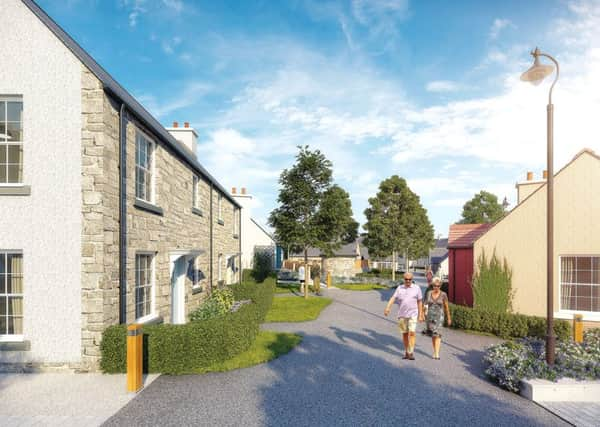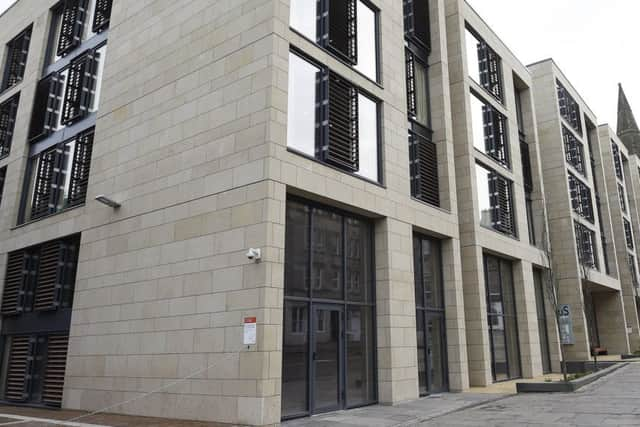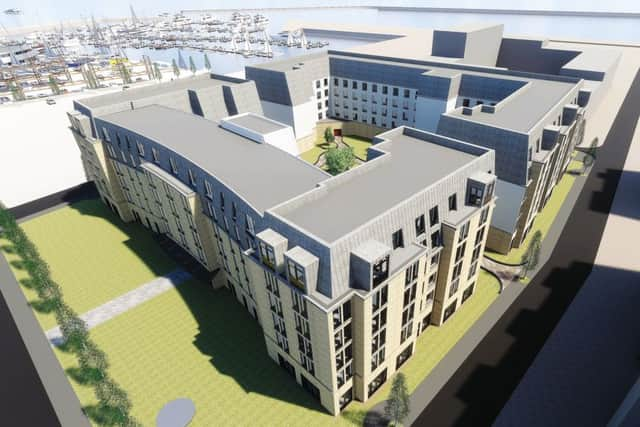Developers adapt to suit buyers at opposite ends of the age scale


But far from being the old people’s home of the British model, these developments target younger retired people – from the age of 55 – and are luxurious in both finish and amenities.
Estate agent Savills’ retirement living specialist Carole Mackie says that model is coming to Scotland and there is a market for it.
Advertisement
Hide AdAdvertisement
Hide Ad“There is a new downsizer in Scotland who is cash-rich, having amassed considerable property equity from the sale of the family home, energetic, modern, outward-looking and young at heart.


“Their wishlist is similar to that of a young professional, with dual incomes and no heavily dependent children.”
According to Savills’ statistics, a quarter of those buying a property in luxury new-build city properties are over 60 years old, challenging the notion that retirees are looking for peace and tranquillity in a bungalow by the sea.
It is this market that companies across Scotland are increasingly tapping into, with a number of high-end projects, with age restrictions on buyers, in development.
The new downsizer’s wishlist still includes important factors such as security and accessibility but this is more likely to mean lift access and vertical living in a chic apartment with all mod cons rather than a compact single-storey house in a cul-de-sac.


Security is less about the owners’ personal safety anxieties and more about their aspiration to lock up and leave to travel the world, safe in the knowledge that their property is wind and watertight, and secure.
Proximity to bars, restaurants and cultural opportunities in a city are also high on the wishlist.
UK-wide developers have been responding to the market demand, but until recently such developments north of the Border have been rare.
Advertisement
Hide AdAdvertisement
Hide AdAccording to Savills, this is because the sale of the family home in Scotland generally generates lower levels of equity for downsizers and retirees than other parts of the UK, which simply means this target group of consumers has less to spend.


Therefore a model that works in London, Bath or Bristol cannot simply be replicated in Edinburgh or Glasgow.
The challenge for developers operating in the retirement sector in Scotland will be providing desirable properties at attainable prices.
McCarthy & Stone, the UK’s largest provider of purpose-built retirement complexes, launched an upmarket product, Ortus Homes, three years ago, since renamed Lifestyle Living, and is building in Murrayfield in Edinburgh, Bearsden and Newton Mearns in Glasgow and Alloway in Ayrshire.
Suzanne McElhiney, senior marketing manager of McCarthy & Stone, says: “We were one of the first in Scotland to enter into the luxury higher specification product aimed at the younger retiree, but there is definitely a demand in the market.


“People are retiring earlier and want a property to allow them to do what they want with the rest of their lives.”
In terms of location, McElhiney says the Lifestyle Living brand needs to be in an area where a premium private retirement option will appeal.
“The places where we are developing are pockets of affluence which older people want either to move in to or stay in after they have sold a larger house.
Advertisement
Hide AdAdvertisement
Hide Ad“There is something of a rush to market coming on board from other providers, as the supply of private retirement accommodation is so small that obviously other developers have now seen the opportunities.”
Purchase prices tend to be comparatively high, but depend on location.
At Lifestyle Living’s Alloway development the price for a two-bedroom flat, for example, starts at £220,000 while in Murrayfield the cheapest one-bedroom was £440,000 and the penthouse was priced at just under £1 million.
A bespoke retirement village, called Liberty Chapelton, is under construction ten miles from Aberdeen.
Due for completion in early 2019, it will provide 94 one- and two-bedroom apartments and cottages, priced between £242,000 and £330,000, plus facilities such as a brasserie, a fire pit and exercise trails. A concierge service will include a 24-hour reception.
Jane Barker, managing director of Liberty Retirement Living, says that, as part of the wider development of Chapelton which will see a town created with 8,000 homes and attended infrastructure, one of the selling points of Liberty Chapelton is that it will be fully integrated into its surroundings.
She says: “It will be part of a whole new community so our village is just over the road from a village green with a bistro, shops, nursery and school within walking distance.
“We are trying to appeal to people who may not need care at the moment but are wanting the reassurance that it will be there in the future.
Advertisement
Hide AdAdvertisement
Hide Ad“You don’t even have to be retired to live here. There is an age restriction of 55 but it is increasingly common for people even over 65 to be working in some capacity.”
Edinburgh Marina Holdings has secured detailed planning permission for its luxury waterside retirement living scheme at Granton, two miles from the city centre.
The developer is Living for Retirement and the homes will form a key element of the forthcoming £500m, 28 hectare Edinburgh Marina redevelopment.
Open to over-55s, the scheme will comprise 104 one, two and three-bedroom luxury apartments, with a range of amenities such as dedicated guest accommodation, round-the-clock concierge service, secure private storage and car parking – with full provision for electric power – set in a private landscaped garden.
Residents will have full access to the new health and wellness centre as well as a private cinema, bistro, lounge, library and fully equipped laundry room. Key to the development’s appeal will be its proximity to the spa and conference hotel, and the marina.
Developer Kevin Fawcett says the properties available are designed to deliver “a level of design and service that raises the bar above any retirement living options currently available in the city”.
Prices have yet to be announced but are commensurate with square foot rates for retirement homes across the city and likely to start below £500,000.
Providing attractive homes to allow owners of large family houses to move is seen as key to keep movement across all aspects of the Scottish market.
Advertisement
Hide AdAdvertisement
Hide AdSavills planner Ruth Highgate, who is based in Glasgow, says: “Many older Scots are stuck in a housing trap. The housing market does not fully meet the demands from older people to downsize into suitable retirement accommodation.
“There are a number of challenges facing the Scottish retirement living sector, including relatively high land prices in Scotland compared to other parts of the UK; lower levels of equity available to downsizers to spend on their next home and an inconsistent approach to planning across Scottish local authorities.
“However, with a growing older population who have a pressing housing need and equity to invest, not only is there a commercial opportunity, but a corporate responsibility for the planning and development sector to address this important market in Scotland.”
Studies in youthful living
Scotland is home to a rising number of students, both from the UK and overseas, and the increase has thrown up opportunities in the purpose-built student accommodation market.
A total of 3,610 student bed spaces were created north of the Border in 2017, according to estate agent Cushman & Wakefield’s UK Student Accommodation Report 2017-18, taking the total number of purpose-built spaces available to 53,360.
The private sector dominates the supply of new developments, delivering 87 per cent of all new beds so far in 2017-18, although universities still provide the largest number of bed spaces.
Student accommodation blocks are a major attraction to investors, particularly those being constructed in the student hotspots of Glasgow and Edinburgh, but the report suggests an oversupply of specific types of property, so developers and investors need to be certain that schemes are designed to deliver the right product in the right location.
Diversifying from the traditional communal bathrooms and single rooms on a shared corridor can reap rewards as today’s students, particularly mature students and those from overseas, demand higher standards of accommodation.
Advertisement
Hide AdAdvertisement
Hide AdBut in what is a relatively new market – and one that is extremely price-sensitive – the vagaries of what students want can be difficult to gauge.
In the last year, the number of ensuite bedrooms and studios being built has gone up across Scotland.
Overall ensuite bed spaces now represent 56 per cent of the student accommodation market and continue to be sought after, while studios account for 12 per cent of all beds but are not so popular in some areas.
The high ratio of ensuites and studios is due in part to new developments in 2017 in the west, such as the 589-bed True Glasgow, which features a helter skelter and a cinema, and iQ’s Elgin Place, which has a sleek, industrial interior, roof terrace, DJ space and gym.
Despite such attractions, monthly rental for studios in Glasgow fell last year, whereas in Edinburgh annual rents for studios in developments such as Unite’s Salisbury Court were up.
David Feeney, advisory associate at Cushman & Wakefield, says: “In a number of cases, studio development has been driven by higher prices rather than by true student demand, which now risks oversupply, which is what we are starting to see in Glasgow where intense competition is suppressing rental growth.
“With a further 8,137 new beds in the pipeline for Glasgow, that is a real cause for concern, with [only] well-located schemes that students perceive as offering value best set to succeed in the future.
“The Edinburgh market, however, remains healthy and the current pipeline of 2,756 new beds should be manageable if providers deliver at rents students can afford.”
Advertisement
Hide AdAdvertisement
Hide AdFeeney believes that, while student tenants do look for ensuite accommodation, a shift in focus away from studios is key to maintaining a resilient accommodation market in the UK.
He says: “Students are looking for more of a social experience, with communal and shared spaces, rather than being socially isolated in a self-contained studio.”
He says potential student renters will consider the value of the experience and this will drive their preferences for accommodation.
“Studios are on average 45 per cent more expensive but do they offer a 45 per cent better experience?”
In terms of investment, Russell Hefferan, associate of student and residential investment at Cushman & Wakefield, added that the high quality student accommodation now available and under construction in Scotland’s two biggest cities is proving attractive to investors.
He says: “We continue to see strong interest from UK investors competing with international investors specifically focusing on UK purpose-built student accommodation stock.
“Edinburgh and Glasgow remain high on their target list of cities.”
Feeney concludes: “The sector will continue to prove attractive to investors and if developers are able to meet student demand for ensuite rooms, rising student numbers will provide suitable and reliable returns.”
This article appears in the Spring 2018 edition of Vision Scotland. Further information about Vision Scotland here.